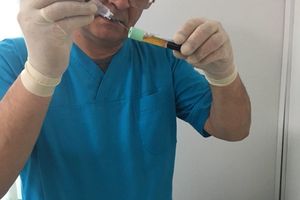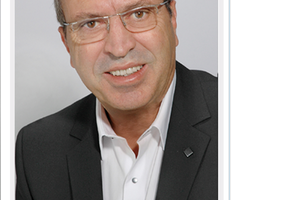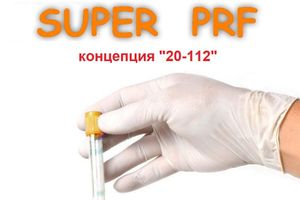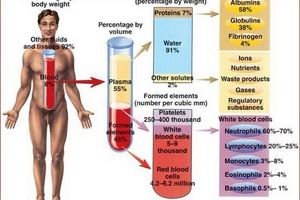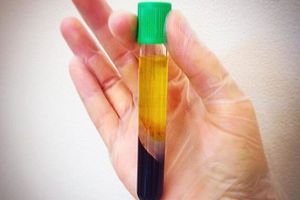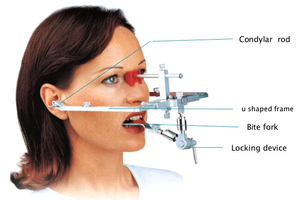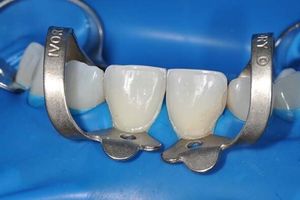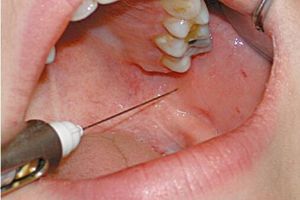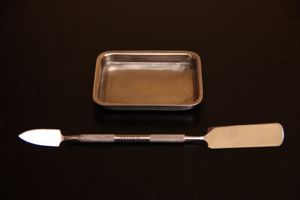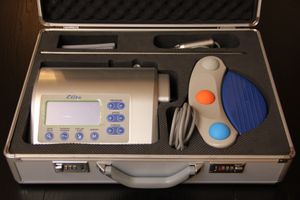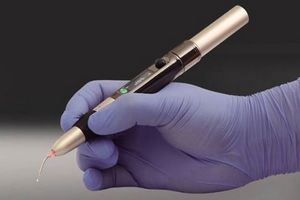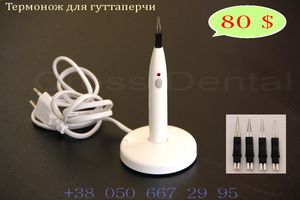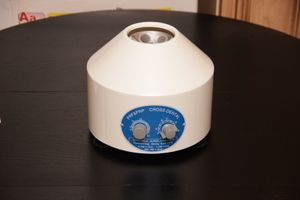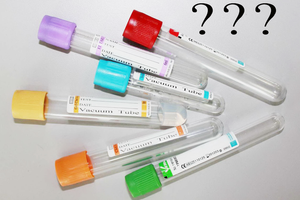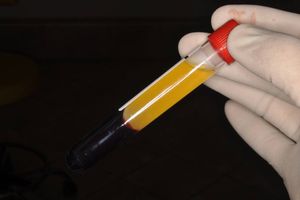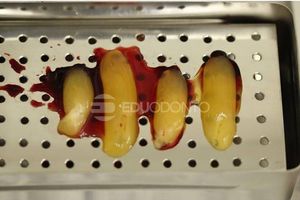This article is our intellectual property and is available for review on the terms of payment of a monetary reward in the amount of the equivalent of $ 10 (US dollars). We entrust payment control to your conscience by analogy with European principles, when, for example, a person pays in good faith for the strawberries he has picked in a foreign field. Payment details for Ukraine: UA093052990000026009005003772 (FOP Verveiko O.M.)
For other countries: 4441114419843634 (Vitalii Verveiko)
PAYPAL: cross-fm2@mail.ru
Plasma therapy has been used in medicine for more than 30 years (traumatology, cosmetology, dentistry, general surgery). Its main meaning is to obtain autologous plasma enriched with platelets (they contain growth factors) from the patient's blood and then inject this plasma into problem areas - targets, so to speak. To do this, using a catheter needle, blood is taken from the patient's cubital vein into a special vacuum sterile tube containing an anticoagulant (sodium citrate, sodium heparin). The blood-filled tube is inverted several times to mix the blood with the anticoagulant and placed in a centrifuge to separate the plasma from the erythrocytes by centrifugation. The resulting plasma is injected into the patient. This is in short. The most important task is to get really platelet-rich plasma. Moreover, these platelets must be "healthy", intact. In the CIS, the Plasmolifting method of plasma therapy, proposed by Russian colleagues, is being actively promoted. The authors did not invent anything new, except for their own method for making a separation gel, patented in 2012. The principle lies in the different density of blood cells and gel, and therefore in the different speed of their settling and a certain sequence of fractions in the test tube after centrifugation. The greater the density of the fraction, the faster this fraction will settle to the bottom of the tube during centrifugation. For example, erythrocytes have the highest density (1.100 g/ml), so erythrocytes will settle first. Then leukocytes will settle, their density is 1.062-1.082 g / ml. The gel should sit on top of the erythrocytes and leukocytes, and above the gel should be platelets with a density of 1.058 g/ml and then plasma with a density of 1.026. Those. erythrocytes with leukocytes below the gel, and platelets with plasma above the gel. Such plasma containing platelets can be used for plasma therapy. Unfortunately, the Plasmolifting technique contains gross errors that the authors did not take into account or missed for some reason, possibly by doing it intentionally. In their patent for the invention of a special separation gel, the authors of the technique erroneously declare a platelet density of 1.030. This value is applicable to blood plasma without formed elements, but not to individual platelets. According to the official publication of the European Committee for Blood Transfusion, the platelet density value is 1.058. Below is a table and a link to the document.
According to patent RU 2 494 788 C1, the authors of Plasmolifting created a separating gel with a density of 1.050 g/ml. The density of platelets (1.058) is greater than the density of the gel, and therefore, in the Plasmolifting test tubes, the centrifugal force will lower them below the gel, therefore, the plasma for injection will be platelet-poor. A few months later, the authors registered a new patent RU2543324C2, in which they already report that the density of their gel is in the range of 1.050-1.060 g/ml. The composition of the gel in the second patent is absolutely identical to the first patent, so many questions arise as to why one value was initially declared, then another. It seems that the conditions of the task were adjusted to the result. But be that as it may, the actual result is no better. Even if we assume that the density of the gel is exactly 1.060, due to the small difference in the density of the gel and platelets, the latter will still tend to plunge into the gel and some of them will fall into the gel trap, the plasma will become poorer from this. And given that the density of the gel is declared as a range, the lower limit of which is lower than the value for platelets (1.050 < 1.058), you can be more than sure that the platelets will definitely “drown” in the gel. That is why there are so many reviews about the greater effectiveness of classical plasma therapy using citrate tubes.
By the way, the very principle of separating plasma and sediment using a separating gel was known long before the Russian patent. Take, for example, the work “Isolation of Human Platelets (Thrombocytes)” (2002) by John M. Graham, professor at the School of Biomolecular Sciences at Liverpool John Moores University. But in his work, the professor suggests using a separating gel (barrier) with a density of 1.063, which is higher than the density of platelets and will not allow them to sink into this gel, leaving them to “float” in the plasma. Such an approach can certainly be considered correct.
It turns out that Russian colleagues borrowed the idea from previous developers, but could not implement it. Perhaps this is due to the insufficient amount of information on the density of blood components, I myself spent several days looking for this data. Or maybe the authors of Plasmolifting tritely misunderstood that the density of blood plasma is not the same as the density of platelets. Or knowingly provided false information. The reason is no longer so important, the main thing is that the method error has been identified.
At the end of the topic of platelet density, I want to note that 1.058 is the average value. There is another study from the Department of Biochemistry, University of Virginia School of Medicine, 1992. According to this study, in human blood, depending on the density, three subpopulations of platelets are distinguished:
- low density (1.040<d<1.065 g/ml) - 24% of the total volume
- intermediate density (1.065<d<1.070 g/ml) - 47% of the total volume
- high density (1.070<d<1.080 g/ml) - 29% of the total volume.
Can you imagine, over 76% of platelets have a density above 1.065! All these platelets, under the action of the centrifugal force of the centrifuge, will easily sink into the gel and pass through it, waving farewell to the plasma. Here is a link to this study: https://www.ncbi.nlm.nih.gov/pubmed/1282829
The next drawback of the Plasmolifting technique is the mandatory need to use a large centrifugal force (835-1400 g) for centrifugation, otherwise erythrocytes with leukocytes simply cannot pass through the gel. This is written in the description of plasmolifting. If you have Plasmolifting test tubes, you can conduct an experiment, centrifuge the blood at a speed 4-6 times lower than usual - your erythrocytes will remain above the gel and partially sink into it. Such a large centrifugal force required for the Plasmolifting technique inevitably damages platelets, and also immerses them in an erythrocyte and gel trap. This is mentioned by Professor John M. Graham in the above mentioned work. As a result, the plasma will be depleted.
Summing up the results of this discussion of the Plasmolifting methodology, I will highlight the main theses:
The authors of Plasmolifting worked with erroneous input data, the actual platelet density is 1.058, not 1.030, as they stated.
In this regard, the density of the gel in the Plasmolifting test tubes was chosen incorrectly.
Platelets containing growth factors are immersed in the gel, as a result of which the plasma becomes poorer, the effect of injections is significantly reduced.
Gel is evil! It is impossible to achieve perfect separation of blood fractions with just a gel! The density of platelets and the density of the lightest leukocytes are approximately the same. In terms of density, they can be considered one fraction.
All these shortcomings are eliminated in the author's technique SUPERPLASMA. There are many more growth factors in Superplasma, platelets are not damaged, and their concentration is much higher than in Plasmolifting test tubes. You can learn more about the Super Plasma technique at this LINK.
Tubes for Superplasma can be ordered HERE
Rewriting, full or partial copying of this article is prohibited!










